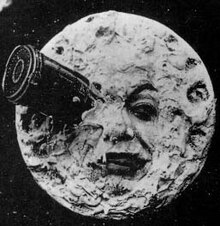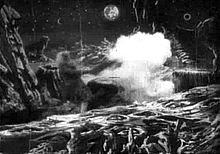A Trip to the Moon




A Trip to the Moon (French: Le Voyage dans la Lune) is a 1902 French silent film and the best-known of the hundreds of films made by director Georges Méliès. Named the 84th greatest film of the 20th century by The Village Voice, it is widely regarded as the earliest example of the science fiction film genre and, more generally, as one of the most influential films in cinema history. The film follows a group of astronomers who travel to the moon in a cannon-propelled capsule, explore the moon's surface, escape from an underground group of Selenites (Lunar inhabitants), and return with a splashdown to Earth with a captive Selenite.
- Written, produced, and directed by George Méliès, inspired by a wide variety of sources, including Jules Verne's novels From the Earth to the Moon and Around the Moon.
Quote from the film
[edit]Quotes about the film
[edit]A
[edit]- As the longest and most expensive of the early féeries, Le Voyage dans la lune constitutes not only a culmination of Méliès's work but also a significant advance. It mixes theatrical and cinematic devices in both old and new ways, it privileges clous f spectacle by means of extended narrative continuity, and, surprisingly, it experiments with dividing up and reconstituting the autonomous shot-scene.
- Richard Abel, "The Cinema of Attractions, 1896–1904," Ch. 3 of The Ciné Goes to Town: French Cinema 1896–1914 (Updated and Expanded Edition, Los Angeles, CA: University of California Press, 1994), p. 71.
- The middle section of Le Voyage dans la lune, where the scientists actually explore the moon, may break no new ground in its display of trick effects and spectacular decors, yet that hardly detracts from its achievement. The rocket sinks below the lunar surface, for instance, while the earth seems to rise in the far background sky, a "dream" of celestrial bodies hovers over the sleeping scientists, ending in a shower of snowflakes, and Selenites keep disappearing in puffs of smoke.
- Richard Abel, "The Cinema of Attractions, 1896–1904," Ch. 3 of The Ciné Goes to Town: French Cinema 1896–1914 (Updated and Expanded Edition, Los Angeles, CA: University of California Press, 1994), p. 72.
E
[edit]- Méliès also created edited sequences by breaking scenes down into several discrete shots, sometimes resulting in an effect of rapid montage, as in Le Voyage dans la lune/A Trip to the Moon (1902), in which the rocket's descent to Earth is shown in a four-shot sequence lasting two-and-a-half seconds.
- Elizabeth Ezra, "Méliès does tricks," Ch. 1 of George Méliès (Manchester, U. K.: Manchester University Press, 2000), p. 33.
- Made in 1902, Le Voyage dans la lune was the film that first brought Méliès international fame—and it is the film that, even today, is the most widely recognized of Méliès's works. At first, however, he had difficulty persuading fairground exhibitors to buy it because of the high price resulting from the film's lavish production costs; so he lent the film to exhibitors free of charge for a single showing, confident that its popularity with audiences would convince exhibitors that they would recoup his asking price.
- Elizabeth Ezra, "Imaginary voyages," Ch. 4 of George Méliès (Manchester, U. K.: Manchester University Press, 2000), p. 120.
- Le Voyage dans la lune was not only the first science fiction film, but also the first cinematic spoof of the genre.
- Elizabeth Ezra, "Imaginary voyages," Ch. 4 of George Méliès (Manchester, U. K.: Manchester University Press, 2000), p. 120.
- In its depiction of the exploration of a faraway place and hostile encounter with alien life forms, Le Voyage dans la lune can easily be read as a parable of colonial conflict.
- Elizabeth Ezra, "Imaginary voyages," Ch. 4 of George Méliès (Manchester, U. K.: Manchester University Press, 2000), p. 120.
- Subtending this film is a satire of social hierarchy: the interplanetary explorers' stint at the Selenites' court mirrors the hierarchical structure depicted at the scientific congress, as Barbenfouillis presides over his scientific disciples, the power conferred upon him by his intellectual prowess as arbitrary and absurd as that invoked by the crustacean king. Le Voyage dans la lune ultimately shows that, rather than being safely out of this world, the differences encountered by the intrepid explorers were very close to home.
- Elizabeth Ezra, "Imaginary voyages," Ch. 4 of George Méliès (Manchester, U. K.: Manchester University Press, 2000), pp. 125–126.
J
[edit]- The film— Méliès's 400th production—cost him an extravagant 10,000 francs, his most erxpensive project to date. It became a hit around the world almost instantly, largely because of its pioneering special effects and innovative filmmaking techniques, which included double exposures, dissolves and fades, and elaborate sets contrived to depict extraterrestrial spaces. Audiences had never seen anything like it before. It was the 'newest' thing in town, playing at some venues for months.
- Carolyn Jess-Cooke, Film Sequels (Edinburgh: Edinburgh University Press, 2009).
K
[edit]- In one of his greatest films, A TRIP TO THE MOON (Le Voyage dans la lune), the moon harbors a grimacing man in the moon and the stars a bull's-eyes studded with pretty faces of music hall girls.
- Siegfried Kracauer, "Basic Concepts," Ch. 2 of Theory of Film: The Redemption of Physical Reality (Princeton, N. J.: Princeton University Press, 1997; orig. 1960), p. 33.
M
[edit]A great number of French, English and American manufacturers of films who are searching for novelties, but lack the ingenuity to produce them, have found it easier and more economical to advertise their poor copies as their own original conceptions. This accounts for the simultaneous appearance in several issues of a well known New York paper of advertisements of the celebrated Trip to the Moonby four or five different concerns, each pretending to be its creator. All these pretensions are false. The Trip to the Moon as well as Gulliver's Travels, The Astronomer's Dream, Cincerella, Red Riding Hood, Blue Beard, Joan of Arc Christmas Dream etc., are the personal creations of Mr. George Melies, who himself conceived the ideas, painted the accessories and acted on the stage.
In opening a factory and offices in New York we are prepared and determined energetically to pursue all counterfeiters and pirates. We will not speak twice; we will act.
- Gaston Méliès, "Caution," Catalogue of the Star Film Company (1902).
R
[edit]- Dear Mr. Levy:
Your recent letter to Mr. James Beggs asks whether the Apollo (and previous era spacecraft) "splashdown" recovery technique owes anything to George Méliès' film Le Voyage dans la lune. Although the similarities are striking, the recovery technique used for the Mercury, Gemini and Apollo capsules was dictated more by the then-current engineering capabilities than any imaginative interplay between the engineers and Monsieur Méliès.- Charles R. Redmond, Public Affairs Officer, Office of Space Flight, letter to David Levy (25 February 1985).
Cast
[edit]- Georges Méliès — Professor Barbenfouillis
- Bleuette Bernon — Phoebe (the lady on the crescent moon)
- François Lallement — the officer of the marines
- Henri Delannoy — the captain of the rocket
- Jules-Eugène Legris — the parade leader
- Victor André, Delpierre, Farjaux, Kelm, and Brunnet — the astronomers
External links
[edit]- A Trip to the Moon quotes at the Internet Movie Database
- A Trip to the Moon at Allmovie
- A Trip to the Moon at Rotten Tomatoes
- Was the NASA splash down inspired by Georges Méliès? — A letter to NASA
- The hand-colored, restored version of A Trip to the Moon on Hulu
- A Trip to the Moon complete film on YouTube


